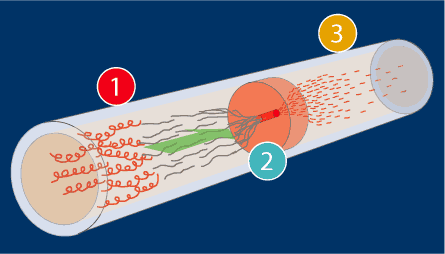DNA to be sequenced is usually received from collaborators as large (150-200 kb) fragments of purified genomic DNA on ice. We keep the DNA in a very cold freezer (-80°C) until we’re ready to start.
The first step is shearing the large fragments. Since DNA sequencing machines can only sequence small strands of DNA, the strands are sheared into many little pieces by a HydroShear machine.
The HydroShear uses hydrodynamic (water jet) shearing forces to fragment DNA strands.

![]() The HydroShear takes up the sample containing long strands of source DNA.
The HydroShear takes up the sample containing long strands of source DNA.
![]() The sample passes through a narrow tube where it is forced through a small aperture in a ruby, and fragments are randomly snapped (sheared) as the DNA is stretched.
The sample passes through a narrow tube where it is forced through a small aperture in a ruby, and fragments are randomly snapped (sheared) as the DNA is stretched.
![]() Short sheared fragments (2-4 kb) pass through and are collected for the next step.
Short sheared fragments (2-4 kb) pass through and are collected for the next step.